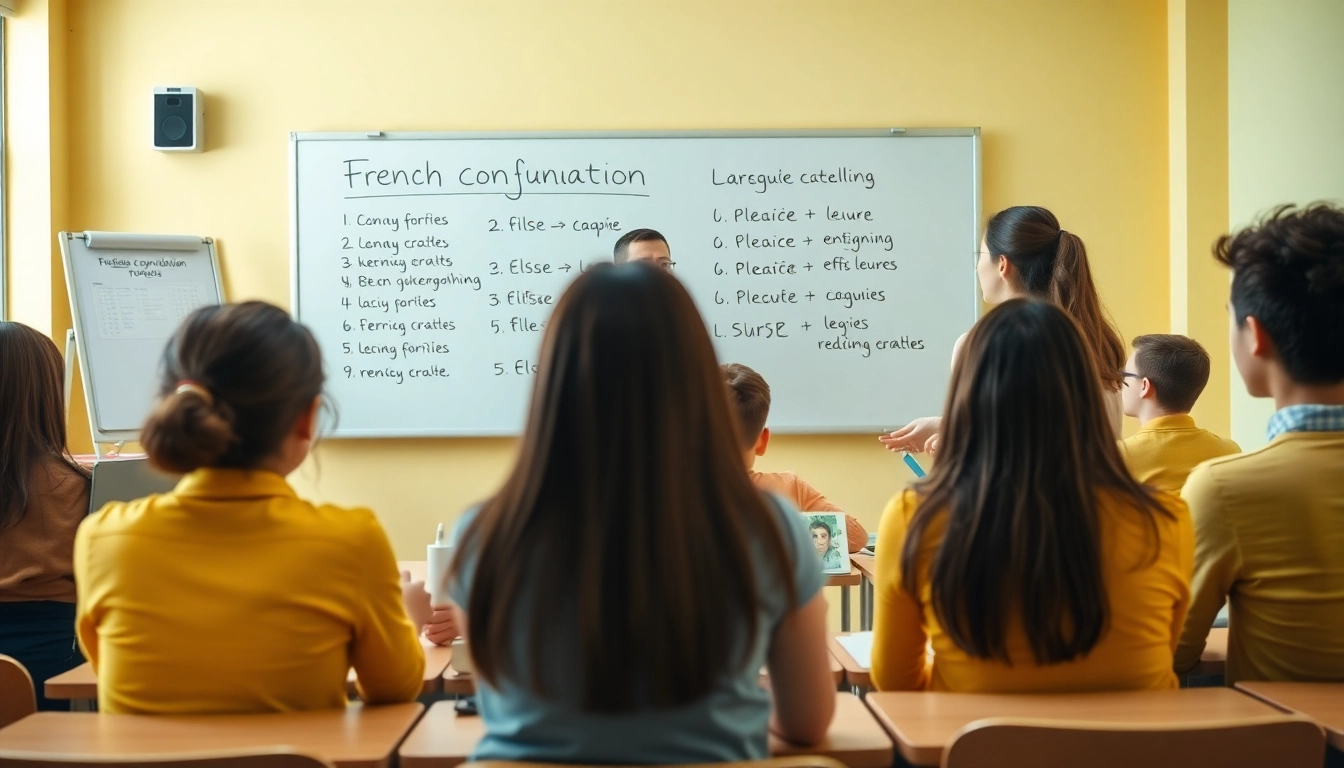Introduction to French Conjugation
The French language, known for its beauty and complexity, heavily relies on verb conjugation as a critical aspect of grammar. French conjugation involves altering a verb to reflect various features such as tense, mood, person, and number. Understanding these changes is not just about memorization; it’s about manipulating language to convey meaning accurately. For learners, mastering French conjugation can be one of the most challenging parts of language acquisition, yet it serves as a gateway to fluent communication.
Understanding Verb Conjugation Basics
At its core, verb conjugation involves changing the form of a verb based on various criteria. This transformation affects verbs in different ways depending on whether they are regular or irregular, as well as their tense and mood.
In French, each verb is categorized into one of three groups based on its infinitive ending: -ER, -IR, or -RE. A grasp of these categories forms the foundation of proper conjugation. For instance, regular verbs in these groups typically follow patterns, which learners can exploit to predict how to conjugate them across various tenses.
Importance of Conjugation in Language Learning
Conjugation is essential for effective communication. Correct verb usage enables speakers to convey not just actions but also nuances related to time and context. For instance, saying “Je mange” (I eat) versus “Je mangerai” (I will eat) changes the meaning significantly. This distinction is vital for clear communication.
Moreover, verb conjugation fosters deeper engagement with the language. Through conjugating verbs, learners engage with French not only as a set of vocabulary but as a living, structured communication tool, enriching their overall learning experience.
Common Challenges Faced by Learners
Despite its importance, many learners find conjugation daunting. Irregular verbs, which do not follow standard patterns, often present the most significant challenges. Additionally, the variety of tenses and moods can create confusion. Learners may feel overwhelmed when trying to remember numerous forms across different categories.
Furthermore, the subtleties of informal speech versus formal communication can add another layer of complexity. It is not just the ability to verbally express oneself in correct forms but also to do so in a way that is culturally sensitive and contextually appropriate.
Conjugating Regular Verbs in French
Overview of -ER, -IR, and -RE Verbs
Regular verbs in French neatly fit into three categories: -ER, -IR, and -RE. Each category has its own conjugation rules that learners can quickly memorize.
-ER verbs are by far the most common and include verbs like “parler” (to speak) and “aimer” (to love). The conjugation typically involves removing the -ER ending and adding the appropriate endings based on the subject pronoun.
-IR verbs, such as “finir” (to finish) and “choisir” (to choose), have a different set of endings. For example, the first-person singular present tense is formed as “je finis”.
-RE verbs, while they form a smaller group, include important verbs such as “vendre” (to sell) and “entendre” (to hear). The conjugation pattern requires dropping the -RE and adding the unique endings.
Step-by-Step Conjugation Examples
Let’s take a look at each category in depth.
-ER Verbs Example: Parler
To conjugate “parler” (to speak) in the present tense:
- Je parle (I speak)
- Tu parles (You speak)
- Il/Elle parle (He/She speaks)
- Nous parlons (We speak)
- Vous parlez (You speak)
- Ils/Elles parlent (They speak)
-IR Verbs Example: Finir
To conjugate “finir” (to finish) in the present tense:
- Je finis (I finish)
- Tu finis (You finish)
- Il/Elle finit (He/She finishes)
- Nous finissons (We finish)
- Vous finissez (You finish)
- Ils/Elles finissent (They finish)
-RE Verbs Example: Vendre
To conjugate “vendre” (to sell) in the present tense:
- Je vends (I sell)
- Tu vends (You sell)
- Il/Elle vend (He/She sells)
- Nous vendons (We sell)
- Vous vendez (You sell)
- Ils/Elles vendent (They sell)
Practice Exercises to Reinforce Learning
Practicing conjugation forms solidifies understanding. Here are some exercises:
- Conjugate the following verbs in the present tense: “aimer” (to like), “choisir” (to choose), “entendre” (to hear).
- Write sentences using each of the conjugated verbs in the first-person singular form.
- Identify and correct the mistakes in a series of sentences containing conjugated verbs.
Additionally, using flashcards can be an effective tool for memorization, as well as utilizing apps or resources dedicated to French conjugation.
Exploring Irregular French Conjugation
Identifying Common Irregular Verbs
Irregular verbs in French defy standard conjugation rules and require special attention. Some of the most frequently used irregular verbs include:
- Être (to be)
- Avoir (to have)
- Aller (to go)
- Faire (to do)
- Venir (to come)
Each of these verbs has unique forms that must be memorized, as they do not follow the conventional patterns established by regular verbs.
Techniques for Memorizing Irregular Forms
Memorizing irregular verbs can be particularly challenging. Here are some techniques:
- Flashcards: Create flashcards for each verb with the infinitive on one side and conjugated forms on the other to facilitate quick recall.
- Mnemonics: Utilize mnemonic devices to create associations that may aid in remembering specific forms.
- Repetition: Regularly practice writing and speaking these verbs in various contexts to reinforce memory.
Interactive Tools and Resources for Practice
Various tools can enhance the learning experience. Online platforms offer interactive exercises and quizzes that provide immediate feedback. Some applications allow learners to practice conjugation in a gamified format, adding an element of enjoyment to the learning process.
Incorporating voice recognition technology in practice can also be beneficial. Hearing oneself pronounce and conjugate verbs can bolster confidence and improve fluency.
Understanding Tenses and Moods in French Conjugation
Present, Past, and Future Tenses Explained
French conjugation encompasses multiple tenses, each serving a unique function. The present tense conveys actions occurring now, while the past tense indicates actions that have already taken place. The future tense is used to describe forthcoming actions.
In the present tense, verbs like “manger” (to eat) can reflect immediate action: “Je mange” (I am eating). For the past, the passé composé is commonly employed, using auxiliary verbs: “J’ai mangé” (I have eaten). The future can be expressed with the futur proche: “Je vais manger” (I am going to eat).
Subjunctive Mood and Its Importance
The subjunctive mood is essential for expressing doubt, desire, necessity, or emotion. While not as common as the indicative mood, understanding the subjunctive opens up students to more nuanced expressions. For instance, in the phrase “Il faut que je sois” (It is necessary that I be), the subjunctive form “sois” is used instead of the indicative “suis.”
Due to its complexity, practice with the subjunctive often requires specific exercises that focus on trigger phrases that precede its use.
Integrating Tenses into Conversational French
To communicate effectively, integrating various tenses into spontaneous conversation is critical. This requires practice in both speaking and writing, where learners can simulate different scenarios:
- Describe a typical day using the present tense.
- Share past experiences using the passé composé.
- Discuss future plans using the futur proche.
Being comfortable with transitioning between tenses allows for richer and more versatile dialogue in French.
Advanced Techniques for Mastering French Conjugation
Building Fluency through Practice
Fluency in French conjugation comes through persistent practice. Immersive experiences, such as speaking with native speakers or consuming French media, can greatly enhance one’s understanding and application of verbs in context.
Engaging in role-playing activities where learners must use specific tenses can also be helpful. Such exercises challenge learners to think on their feet and use French conjugation naturally.
Tips for Advanced Learners
For advanced learners, diving into complex texts can boost comprehension. This includes reading literature, articles, or academic papers in French. Analyzing verb conjugations in these contexts can provide insights into more sophisticated sentence structures and verb nuances.
Additionally, participating in language exchange programs or discussion forums can facilitate deeper engagement with the language.
Utilizing Technology to Enhance Learning
Technology offers numerous platforms for mastering French conjugation. Language learning apps provide personalized lessons, tracking progress over time. Online forums can connect learners for practice, while social media can serve as an informal space for dialogue and language exchange.
Through interactive platforms, learners can test their knowledge in real-time, ensuring continuous engagement and learning reinforcement.















Leave a Reply